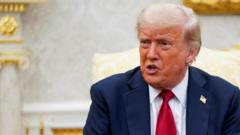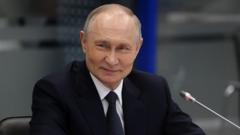China's economy shows signs of slowing growth due to ongoing trade challenges and a crisis in the real estate sector, despite government measures aimed at stabilization.
China's Economic Growth Faces Turbulence Amid Trade Strife

China's Economic Growth Faces Turbulence Amid Trade Strife
Economic slowdown influenced by trade tensions and property market woes.
China's economy has exhibited signs of deceleration as trade tensions stemming from U.S. tariffs and a continued crisis in the property market bring mounting challenges. According to data released by China's National Bureau of Statistics, the nation's growth rate was recorded at 5.2% for the three months ending in June, a slight dip from 5.4% in the previous quarter.
Despite fears of a more dramatic downturn, the central government has implemented various support measures that appear to have mitigated the impact of these challenges. The Bureau stated that the economy "withstood pressure and made steady improvement," largely due to 6.4% growth in manufacturing spurred by demand for innovative technologies such as 3D printing, electric vehicles, and industrial robotics.
However, the retail sector showcased weakness in June, with growth in sales declining to 4.8% compared to 6.4% in May, indicating lukewarm consumer demand. Additionally, new home prices in China experienced their most significant monthly drop in eight months, underscoring the ongoing turmoil within the property industry, despite government interventions intended to shore up property prices.
Economists are beginning to speculate that China may fall short of its target annual growth rate of "around 5%." Dan Wang, director for China at Eurasia Group consultancy, highlights the uncertainty, stating, "The real question is by how much. We believe it will defend a floor of 4%, which remains the minimum politically acceptable level."
The trade conflict, initiated between U.S. President Donald Trump and China's President Xi Jinping, resulted in hefty tariffs, including a staggering 145% levy on Chinese imports from the U.S. and a 125% duty on certain American goods from China. A temporary truce, recently achieved after negotiations in Geneva and London, leaves the two nations with a deadline of August 12 to formulate a lasting trade agreement, which adds another layer of uncertainty to China's economic outlook.
Despite fears of a more dramatic downturn, the central government has implemented various support measures that appear to have mitigated the impact of these challenges. The Bureau stated that the economy "withstood pressure and made steady improvement," largely due to 6.4% growth in manufacturing spurred by demand for innovative technologies such as 3D printing, electric vehicles, and industrial robotics.
However, the retail sector showcased weakness in June, with growth in sales declining to 4.8% compared to 6.4% in May, indicating lukewarm consumer demand. Additionally, new home prices in China experienced their most significant monthly drop in eight months, underscoring the ongoing turmoil within the property industry, despite government interventions intended to shore up property prices.
Economists are beginning to speculate that China may fall short of its target annual growth rate of "around 5%." Dan Wang, director for China at Eurasia Group consultancy, highlights the uncertainty, stating, "The real question is by how much. We believe it will defend a floor of 4%, which remains the minimum politically acceptable level."
The trade conflict, initiated between U.S. President Donald Trump and China's President Xi Jinping, resulted in hefty tariffs, including a staggering 145% levy on Chinese imports from the U.S. and a 125% duty on certain American goods from China. A temporary truce, recently achieved after negotiations in Geneva and London, leaves the two nations with a deadline of August 12 to formulate a lasting trade agreement, which adds another layer of uncertainty to China's economic outlook.



















